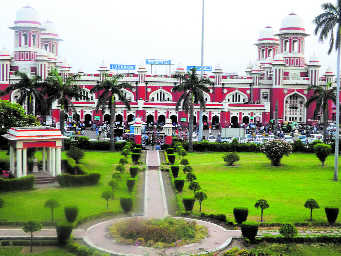I have just returned from a short trip to Lucknow, after attending a prayer meeting for a beloved aunt who passed away aged 97. She was one of my last links with a Lucknow that exists only in my memory. Almost all the old neighbours and relatives of my parents' generation have passed on and their old houses are no longer recognizable. Some have been torn down after they were bought by developers, others are in a shabby, decrepit state because no one really lives there any more…the story is the same in city after city that I visit.
For close to forty years, my mother lived in a government colony called Gulistan that was on the opposite side of Lucknow's railway colony, the Raj Bhawan complex, Loreto Convent (known locally as the Bhaktin iskool), and separated from the sprawling cantonment by a small foot-bridge called Katiya Pul because several suicides or accidents took place on the busy railway track it spanned. Huge shady trees, wide avenues, old gracious bungalows with lawns and gardens - these are what I often dream about even today when I recall those years. It had the most delightfully evocative names: the Zoo was called Bandariya Bagh, the Museum was 'Murda Ajayabghar' and the village that surrounded the famous La Martiniere School was known as Martinpurwa. Beyond it was the river Gomti that formed the boundary of this magical landscape.
After my mother passed away, I only visited Lucknow for a family celebration or some such occasion. Friends from there would tell me how the old Lucknow was almost gone and the familiar landmarks of our youth -- bookshops, restaurants and old-style sari shops -- had shut down as their owners passed on or sold out. Even the grand Mayfair Cinema with the iconic Kwality restaurant was gone, as was the British Council Library - our favourite haunt on hot summer afternoons. It hurt me each time such news came to my ears but who was I to complain? After all, I was one of the many who had forsaken my beloved 'maika'. As the wise poet Nida Fazli once observed, when its residents go away, a city waits for their return for a few years and then, heart-broken, it quietly moves to another place.
Something like this has happened to my Lucknow. In the last few years, a wholly new township has sprung up on the other side of the Gomti, on what were once the river's floodplains and the site of the most delicious and aromatic melon farms. Today, there are smart new flyovers that whisk you over these sandy tracts and the new city that lies in front of your eyes is a throbbing metropolis with malls, five-star hotels and hospitals, apartment complexes with fancy names and busy shopping complexes. The roads are still a work in progress, so after a smooth ride one is liable to crack one's skull as the car bounces over rubble and stones left by some departing developer.
Since we were staying with a niece in the cantonment, we still got a taste of the old life. Tea and newspapers on the lawn in the morning when pigeons and birds would fly down to peck at the grain they were offered. Peacocks called to each other from the wooded area behind the house as we gazed at the magnificent palash tree in bloom and the 'baur' on the mango trees. Later, we crossed over to the other house in Gomti Nagar to spend the day with our cousins who have moved there to a new apartment complex for security and convenience. Believe me, it was like living in two time zones: the nineteenth century and the twenty-first. It was an experience that will take me a long time to digest.
Pragmatists may think I am being needlessly sentimental and that this is the new reality of our old cities. After all, the Smart City that one hears so much about is a response to the call of a young and aspirational India that is fed up of the potholed roads, urban squalor and garbage of our old cities that are slowly sinking under the weight of their own waste. They want to live in a clean, new environment where everything works and looks smart. And why not?
Yet, before we throw out the old, should we pause to reflect on what we are building in its place? More importantly, what are the values that we are endorsing by genuflecting before the glitter and glitz of the new townships? Underneath the smooth exterior of the apartment complexes that shine like stately ships at night are restless and unhappy nuclear families. As they sit in front of their television screens, their minds are with their progeny who can only send Whatsapp messages, studded with the appropriate emoticons, to register their sorrow. The customary rituals that brought the far-flung members of a clan together on such occasions have been cast aside for church-style memorial meetings in tacky temples. No one knows quite what to do at the conclusion of such an event: smile, weep, what?
Hovering between the memory of an old clan and the reality of a nuclear family, I returned saddened to my soul.
Unlock Exclusive Insights with The Tribune Premium
Take your experience further with Premium access.
Thought-provoking Opinions, Expert Analysis, In-depth Insights and other Member Only Benefits
Already a Member? Sign In Now










